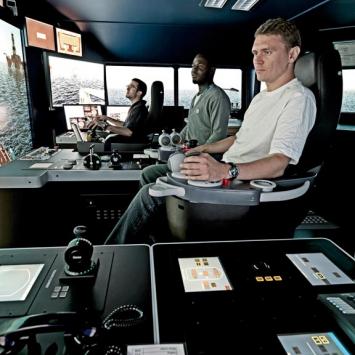Dynamic Positioning (DP) Basic Induction - 4 day version
PURPOSE
To acquire knowledge of the principles of DP.
To acquire a basic understanding of how to set up a DP system.
To get an understanding of the practical operation of associated equipment, including
position reference systems.
To recognise the various alarm, warning and information messages.
To relate the DP installation to the ship system, including (but not limited to) power
supply, manoeuvring facility, available position reference systems and nature of work.
To relate DP operations to the existing environmental conditions of wind, sea state,
current/tidal stream and vessel movement.
CONTENT
The training is based on the program outlined by the Nautical Institute Scheme of Training. Training is a mix of theoretical sessions and practical exercises on Kongsberg DP stand-alone simulators. All training is conducted as classroom training.
OBJECTIVE
Clear objectives are set in Nautical Institute’s Training Scheme. summarised as follows;
DP Control Station
Define Dynamic Positioning and use of same.
Define main components in the DP system and role of same, including advantages and
disadvantages in the use of the DP.
Discuss concept of mathematical model, and consequence analysis.
Power Generation and Management
Describe the power generation and distribution arrangements in a typical hybrid diesel/
diesel-electric DP vessel, with particular reference to system redundancy as described in
IMO MSC Circ. 645 and vessel FMEA.
Describe the functions of a power management system as installed on Class 2 and Class 3 DP
vessels and explain the concept of available power and spinning reserve in worst case
failure.
Describe the provision of uninterruptible power supply to the DP system.
PROPULSION UNITS
Describe the types of propulsion systems commonly installed in DP equipped vessels
Position Reference Systems
Describe the operation, principles and limitations of position reference systems in
general.
Sensors (Heading, Motion, Environmenta and External):
Describe all sensor inputs, how they work, what they do and limitations.
Describe the use of external force reference systems such as hawser tension, plough cable
tension and pipe tension monitoring.
DP Operations
Describe/explain the need for procedures, checklists and logbook entries, emergency and
contingency planning.
Describe the alarm messages provided on the DP system displays and on the DP printer, and
recognize
the alarms/warnings associated with loss of redundancy after worst case failure.
Explain the use of worksite diagrams using Universal Transverse Mercator (UTM) coordinates,
projections and datum.
List various providers of documentation and classification societies.
Describe the hazards associated with DP operations conducted in areas with very deep water,
shallow water and/or strong tidal conditions.
Practical Operation of a DP System
Demonstrate the correct procedure for setting up on DP, and maneuvering in the different
modes.
ASSESSMENT
In order to be awarded a certificate of completion for the Induction course the trainee must pass an online assessment at the training centre.
ADMISSION REQUIREMENTS Are defined by the Nautical Institute. Please refer to the “DP Training Certification scheme – 2015” section 2. pages 7-8 on the NI website: http://www.nautinst.org/en/dynamic-positioning/index.cfm
DURATION 4 days
PARTICIPANTS Maximum 8
LANGUAGE Course material is in English.
Course is conducted in Danish or English.


![[ad-side]](http://www.crewing24.com/ad_images/91_banner.png)
![[ad-side]](http://www.crewing24.com/ad_images/87_banner.png)
![[ad-side]](http://www.crewing24.com/ad_images/95_banner.gif)
![[ad-side]](http://www.crewing24.com/ad_images/86_banner.png)
![[ad-side]](http://www.crewing24.com/ad_images/77_banner.gif)
![[ad-side]](http://www.crewing24.com/ad_images/106_banner.jpg)
![[ad-side]](http://www.crewing24.com/ad_images/100_banner.jpg)
![[ad-side]](http://www.crewing24.com/ad_images/105_banner.jpg)
![[ad-side]](http://www.crewing24.com/ad_images/93_banner.jpg)
![[ad-side]](http://www.crewing24.com/ad_images/88_banner.jpg)